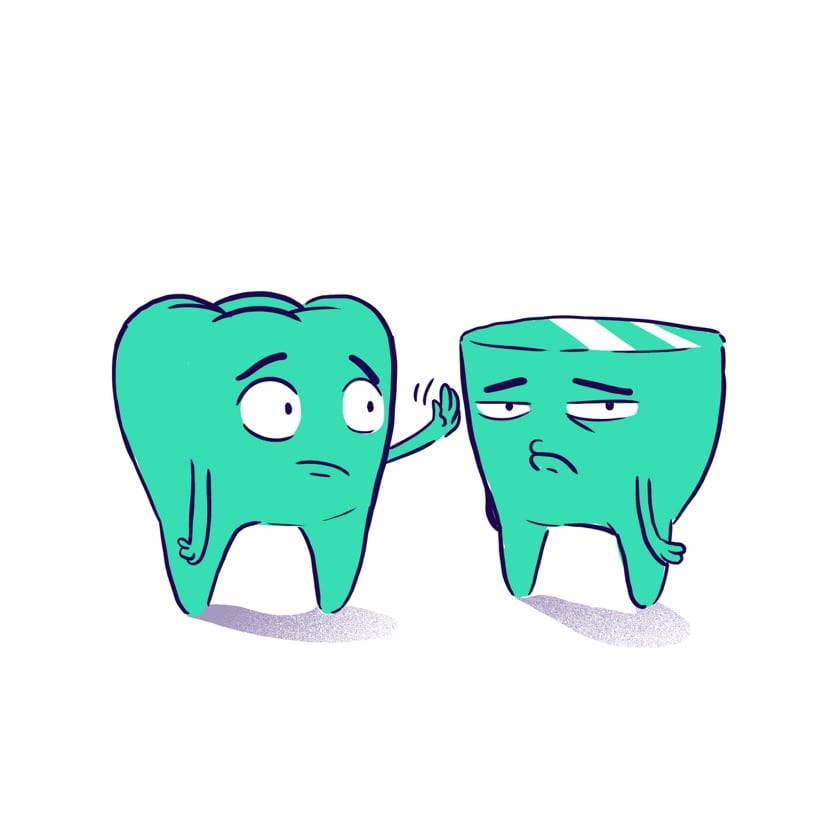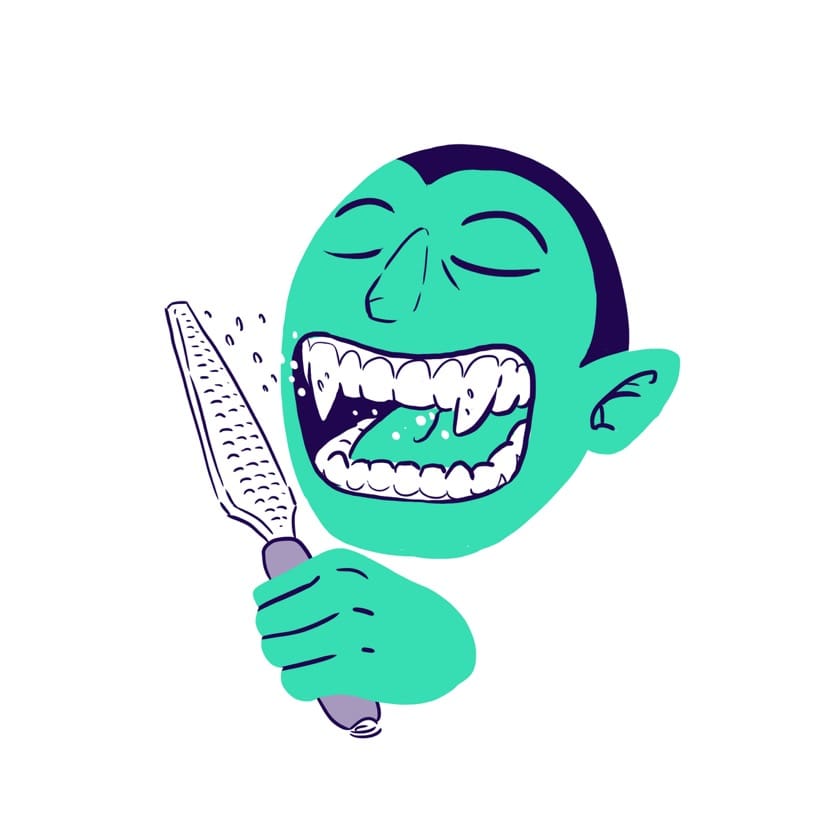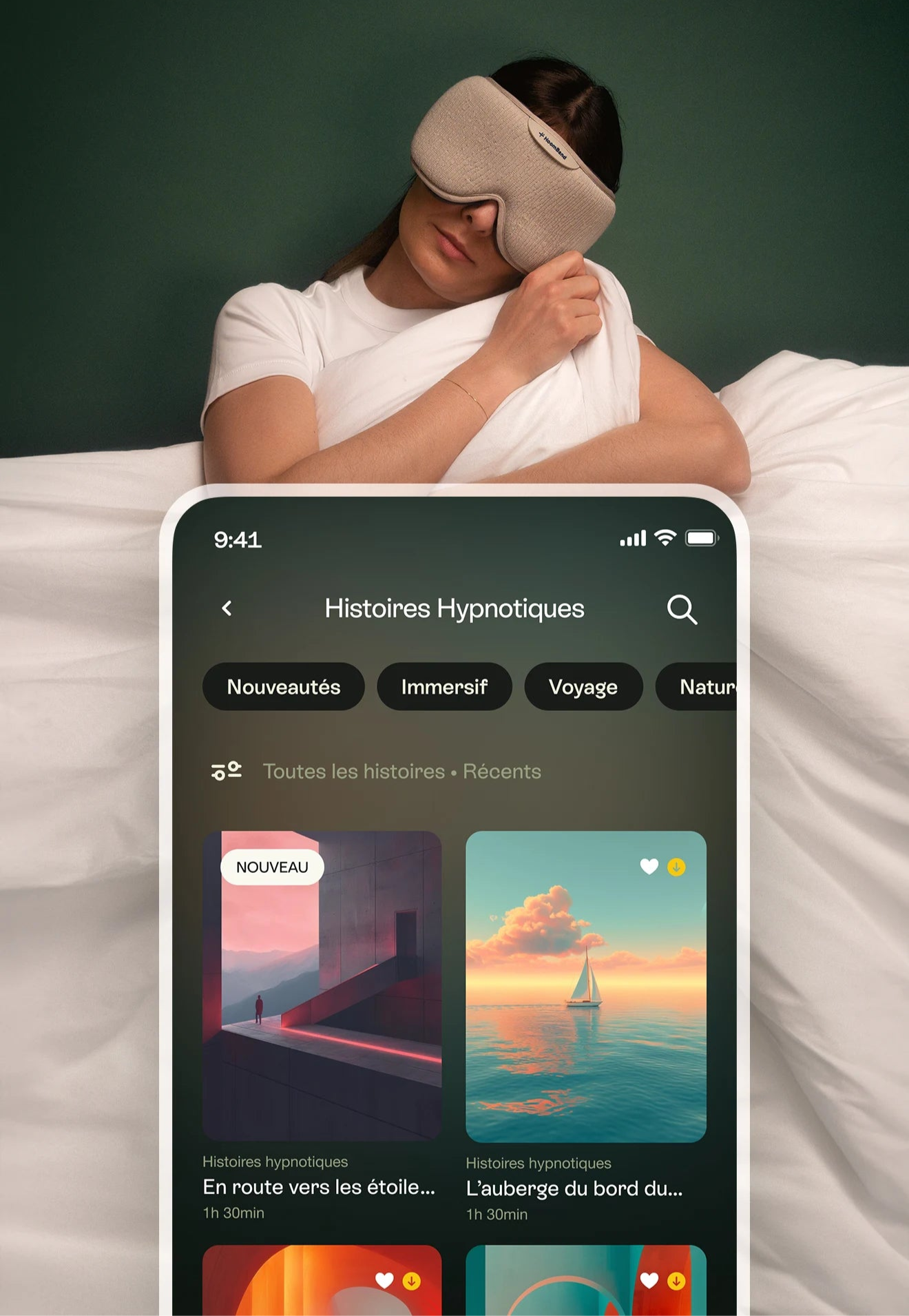What can be done about bruxism?
Have you ever heard of bruxism ? This term, while not very descriptive, can, however, turn out to be a grating subject, in the literal sense, even noisy in some cases. Bruxism is a functional disorder that does not go unnoticed, as it can cause quite significant and disabling physical after-effects, even if it occurs unconsciously.
But then, what do we really know about bruxism, this strange phenomenon which, although not strictly speaking a sleep disorder, can be heard, even without our knowledge, night and day? What can be the causes of bruxism, and what can be done to treat it? To find out (almost) everything about bruxism, click here!
What is bruxism?
Bruxism… The word itself doesn't give us much insight into what it refers to, unless you were an attentive student in Greek class! In fact, the word bruxism comes from the Greek "brugmos," which means "grinding of the teeth." Once you make that little clarification, everything becomes much clearer, doesn't it?
Bruxism is a functional disorder that causes teeth grinding, which can be combined with or substituted by clenching. A bruxomane (a term used to describe a person suffering from bruxism) grinds and/or clenches their teeth involuntarily. This is called a masticatory parafunction , meaning clenching and grinding the teeth without any functional purpose.
This parafunction, like parasomnias (sleep apnea, night terrors, etc.), occurs arbitrarily and unconsciously. Bruxism, although not considered a sleep disorder in its own right, mainly occurs during sleep. This is called nocturnal bruxism . As we will see later, links can be considered between this phenomenon and certain sleep disorders (sleep apnea in particular), which would make bruxism a sleep-related motor disorder. However, another form of this functional disorder can occur during the day; this is called daytime bruxism . The latter is more "conscious" since it occurs when the individual is awake, and is therefore easier to diagnose.

Whether nocturnal or diurnal, bruxism can take two different forms :
- dynamic (or eccentric) bruxism : rubbing of the lower teeth on the upper teeth producing a more or less loud grinding noise
- static (or centered) bruxism : more or less pronounced clenching of the jaw
Additionally, you should know that bruxism, regardless of its type or form, is considered a temporomandibular dysfunction ("TMD"). Knowing this, you're ready to shine in society!
Finally, as a little anecdote, it is believed that originally, or at the evolutionary level, this parafunction would serve to make baby teeth fall out. Now, you will know, a small dose of teeth grinding could allow children to lose their baby teeth more quickly so as not to wait for the tooth fairy too long! This is what we could call "the magic of evolution".
Bruxism in figures
Bruxism may be more widespread than one might think. Several studies on this subject agree on the same prevalence. Indeed, a 2013 study 1 based in particular on questionnaires estimates that bruxism affects between 5.5 and 7.4% of the population. This figure is generally confirmed by a 2016 cross-sectional survey 2 published on the very reputable website " Sleep Research Society ", the latter estimating the prevalence of bruxism in the adult population at 8.6%.
Children are also affected by bruxism, and even to a greater extent than adults. This may seem logical if we consider the evolutionary factor mentioned above. Thus, the estimated prevalence of bruxism in children (between 4 and 17 years old) is between 15% 3 and 26% 4 depending on the studies referred to.
Bruxism therefore affects children more than adults, but what about gender parity on the subject? In light of a 2015 study 5 , parity does indeed exist for this functional disorder since sleep bruxism (nocturnal bruxism) affects men as much as women. On the other hand, daytime bruxism affects women more than men. We may be able to find an explanation for this state of affairs by analyzing the factors linked to bruxism a little later, by noting that nocturnal bruxism and daytime bruxism do not have the same causes! We will come back to this.
While nighttime bruxism is mostly of the eccentric type (lateral grinding of the upper teeth on the lower ones), daytime bruxism is essentially central (continuous clenching of the jaw of a parafunctional type). The " Sleep Foundation 6 " and several studies have found that sleep bruxism is much more widespread than daytime bruxism, accounting for 80% of cases.
The figures show that bruxism occurs at any age, day and night, and in different ways. How can we explain such a phenomenon, and what are its origins? That is the "gritty" question!
What are the causes of bruxism?
Let's be clear: as with many sleep disorders or parasomnias, the exact causes of bruxism are not yet well known. However, a majority of specialists agree that the origins of this phenomenon are multifactorial 7 , but mainly central (linked to the central nervous system) and psycho-affective (stress, anxiety). In addition, psychological, local, genetic or pharmacological mechanisms can also explain this functional disorder. To clarify things, here are the main causes of bruxism 8 :
- psycho-affective influence : stress, anxiety, hyperactivity
- local factors : facial trauma, dental malocclusions, temporomandibular disorders (TMD), inflammation, etc.
- lifestyle : alcohol and tobacco consumption, poor diet
- hormonal mechanisms : endocrine disorder
- pharmacological factors : taking narcotics (ecstasy, cocaine, methamphetamines), taking certain medications (antidepressants, SSRIs, etc.)
- central nervous system lesions : Alzheimer's disease, epilepsy, Parkinson's disease, etc.
- psychiatric disorders (“bruxomania” for psychiatrists): depression, neuroses, schizophrenia, bulimia, anorexia, etc.
In addition, certain predisposing factors exist. As we mentioned previously, while children are particularly affected, some studies have revealed the existence of a genetic predisposition to bruxism. In fact, 37 % of people suffering from bruxism have a close relative (in the first degree) who has suffered from the same disorder during their life.
Furthermore, it seems that bruxism mainly affects women 10 , particularly due to its “emotional component” (aren’t men quite sensitive… to daytime bruxism?) Indeed, the pathophysiologies of daytime and nighttime bruxism are not the same! To summarize, we can consider that:
- Daytime bruxism would be an "emotional" parafunction , a sort of daily tic, linked to stress, anxiety and psychosocial factors, it is therefore irregular and depends on emotional fluctuations
- sleep bruxism would have a “central” origin (CNS), it would be linked to a psycho-affective influence (micro-awakenings during the REM sleep phase)
As you can see, the causes of bruxism are not so easy to identify and categorize. However, if you still have a little space in your memory and in the event that you would like to shine (even more) in society, know that a certain theory " Thegosis " exists. What is it? It is in fact a theory invented by Every 11 , which proposes that bruxism is a habit "inherited from animals, with a biological significance" and which would consist of "keeping sharp and piercing teeth for carnivores" and "maintaining tone in the jaw." This internal animal tension (anger, aggression) or external (faced with a threat or danger) could thus be assimilated to human stress! Could bruxism thus reveal our bestial side?

How does bruxism manifest itself?
Bruxomaniacs very often present the same symptoms, although the consequences of bruxism can vary depending on the intensity and frequency of the disorder. Here are the main symptoms of bruxism 12 :
- premature wear of tooth enamel and/or dentin
- dental hypersensitivity
- pain in the cheeks, ears, temples and jaw (especially upon waking)
- dysfunction of the masticatory system : blocking with closed mouth, blocking with open mouth, clicking when opening the mouth
- periodontal recession (loosening of teeth)
- implant failure (prosthesis wear and/or fracture)
- muscle or spinal pain
To complete the characteristics of bruxism, we can also rely on the work of the AASM ("American Academy of Sleep Medicine") as well as that of several scientists, who have officially defined bruxism in a publication 13 called "International consensus on the assessment of bruxism". According to this consensus, a single isolated symptom is not sufficient to characterize bruxism, hence the following classification 14 of the different characteristic stages ( Lobbezoo 2013):
- Stage 1 : “presence of regular and audible teeth grinding during sleep”
- Stage 2 : “presence of regular and audible dental grinding during sleep with dental wear facets”
- Stage 2 : “presence of regular and audible dental grinding during sleep with dental wear facets, as well as transient jaw pain upon waking, muscular fatigue or difficulty opening the mouth”
How can bruxism be diagnosed?
The " International Consensus on the Assessment of Bruxism " can serve as a basis for diagnosing bruxism, even though it further defines the symptoms. However, it was the ASDA ("American Sleep Disorders Association") that, in 1990, classified the clinical signs that allow the identification of nocturnal bruxism 15 :
- perception of grinding or clenching sounds
- premature tooth wear
- discomfort, fatigue or muscle pain, as well as a clenched jaw upon waking
- hypertrophy of the masseter muscles during vigorous voluntary clenching
It should be noted that the scientific validity of these criteria has not yet been established. Therefore, beyond these "standard" criteria (even if not scientifically proven), polysomnography can also be used to verify a diagnosis of sleep bruxism. This examination, in addition to the clinical examination, remains the most reliable for detecting this functional disorder.
In addition, comorbidities between bruxism and other pathologies have now been proven:
- headaches, tinnitus
- sleep apnea , sleep disorders ("OSA"): 3 to 5% of people suffering from bruxism are also victims of sleep apnea
- gastroesophageal reflux
Since premature tooth wear is one of the main symptoms that helps in diagnosis (along with the "testimony" of collateral victims of the noise emitted by teeth grinding), it is essential to carry out a differential diagnosis in order to eliminate other possible causes of this damaged state of the teeth.
Given the large number of studies and the different criteria established to characterize and diagnose bruxism, we realize that this subject is not easy to understand. There is no formal or scientifically validated diagnosis, but just a set of strongly assumed and relatively standardized criteria (clinical examination of the teeth, polysomnography). We can also add, more marginally, specific recording devices 17 , EMG ("electromyography"), panoramic, or even intra-oral devices.
Finally, to conclude this paragraph and clarify this (creaky) diagnosis a little, here is a summary of the diagnosis of bruxism from the famous “international consensus” established by Lobbezoo in 2013:
- “possible” if determined based on anamnesis and questionnaire
- "probable" if we add clinical examination and study models
- “definitive” if the examination is completed by polysomnography or electromyography
How to treat bruxism?
Bruxism, like many parasomnias and other sleep disorders, does not benefit from a long-term treatment. However, appropriate symptomatic treatment can be used, depending on the specific characteristics of the individuals who are confronted with this functional disorder, or parafunction. Here are the main existing treatments :
- occlusal splint : protects teeth and absorbs jaw force
- Botulinum toxin injection : reduces the strength of the most powerful chewing muscles in order to limit the impact of bruxism
- the NTI-TSS
- CBT (“Cognitive Behavioral Therapy”): can limit the impact of daytime bruxism due to its psychological action
- Hypnosis : relatively effective according to some studies 18
- Biofeedback 19 : behavioral change through electronic detection and stimulus
- Relaxation : stress and anxiety being two of the main supposed causes of bruxism, why not try a relaxation technique, or even test an object specially developed for relaxation such as Hoomband or Dodow , these are simple and effective!
It is not the most talked about sleep-related disorder, it is not the loudest, even though it can make us grind our teeth, but nevertheless, bruxism, whether nocturnal or diurnal, is anything but harmless. Like some of its "cousins" the parasomnias or sleep disorders, the causes of this functional disorder are not clearly established. However, standardized criteria still make it possible to identify it and limit its impact on health, which, in view of its potential consequences on health (premature wear of the teeth, various facial or muscular pains, non-restorative sleep), is already not so bad!
To complement and illustrate this article on bruxism, here is a short video posted online by the “ Osmose ” channel, allowing you to better put this strange phenomenon into perspective!
Sources: [1] Polysomnographic study of the prevalence of sleep bruxism in a population sample , M. Maluly, ML Andersen et al, “Journal of dental research”, July 2013 [2] and [9] Sleep Bruxism-Tooth Grinding Prevalence, Characteristics and Familial Aggregation: A Large Cross-Sectional Survey and Polysomnographic Validation , Samar Khoury, PhD, Maria Clotilde Carra, DMD, PhD et al, “Sleep Research Society”, November 2016 [3] Prevalence and risk factors of sleep bruxism and wake-time tooth clenching in a 7- to 17-yr-old population, Maria Clotilde Carra, Nelly Huynh et al, “European journal of oral sciences” , October 2011 [4] The Prevalence of Bruxism and Correlated Factors in Children Referred to Dental Schools of Tehran, Based on Parent's Report, Bahman Seraj, DDs, Ms, Mehdi Shahrabi, DDs, Ms et al, “Iranian journal of pediatrics” , June 2010 [5] Bruxism: Conceptual discussion and review 1 Bruxism:, RV Murali, Priyadarshni Rangarajan et al, “Journal of pharmacy and bioallied sciences”, April 2015 [6] Bruxism , “Fondation Sommeil” website, 2020 [7] Sleep bruxism: fundamental and clinical aspects , B. Chapotat, O. Robin et al, “Researchgate” website, January 1999 [8] Sleep bruxism neurobiology , F. Aloe, “Sleep Science” website, 2009 [10] Current Treatments of Bruxism , Marc Guaita, DMD, PhD and Birgit Högl, MD et al, “Current treatment options in neurology”, 2016 [11] Sleep bruxism: fundamental and clinical aspects , B. Chapotat, O. Robin et al, site “somme.Université Lyon1”, 2020 [12] Bruxism Management , Sona J. Lal, Kurt K. Weber, “Stats Pearls”, February 2020 [13] International consensus on the assessment of bruxism: Report of a work in progress , F. Lobbezoo, J. Ahlberg et al, “Journal of oral rehabilitation”, June 2018 [14] Bruxism defined and graded: an international consensus , F Lobbezoo 1, J Ahlberg et al, “Journal of oral rehabilitation”, January 2013 [15] and [17] Validity of the diagnosis of sleep bruxism , E. D'Incau, JA Micoulaud Franchi et al, “Revue d'odonto-stomatologie”, October 2017 [16] Relationship between sleep bruxism and sleep respiratory events in patients with obstructive sleep apnea syndrome , Hisashi Hosoya , Hideki Kitaura et al, “Sleep and Breathing”, December 2014 [18] Sleep bruxism treatment , F. Aloe, “Sleep Science” site, 2009 [19] Biofeedback for treatment of awake and sleep bruxism in adults: systematic review protocol , Sasa Ilovar, Danaja Zolger et al, “Systematic reviews”, May 2014


